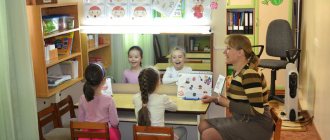Designing a speech therapy lesson in accordance with the requirements of the Federal State Educational Standard for Educational Education
Designing a speech therapy lesson
in accordance with the requirements of the Federal State Educational Standard in preschool educational institutions.
Teacher speech therapist:
Seregina T.G.
.
The specificity of preschool age is such that the achievements of preschool children are determined not by the sum of specific knowledge, abilities and skills, but by a set of personal qualities, including those that ensure the child’s psychological readiness for school.
The Federal State Educational Standard puts at the forefront an individual approach to the child and play, where the intrinsic value of preschool childhood is preserved and where the very nature of the preschooler is preserved. The leading types of children's activities will be: gaming, communicative, motor, cognitive-research, productive, etc.
It should be noted that educational activities are carried out throughout the entire time the child is in the preschool organization.
These are: joint (partnership) activities of the teacher and children:
educational activities in special moments;
organized educational activities;
independent activity of children.
Organized educational activity is the organization of joint activities between a teacher and children:
with one child;
with a subgroup of children;
with a whole group of children.
The choice of the number of children depends on:
age and individual characteristics of children;
type of activity (game, cognitive - research, motor,
productive);
their interest in this activity;
complexity of the material.
But it must be remembered that every child should receive the same
starting opportunities for schooling.
The main feature of the organization of educational activities in preschool educational institutions at the present stage is the departure from educational activities (classes), increasing the status of play as the main activity of preschool children; inclusion in the process of effective forms of work with children: ICT, project activities, gaming, problem-based learning situations as part of the integration of educational areas.
Thus, “class” as a specially organized form of educational
Kindergarten activities are cancelled. The activity should be a specific children's activity that is interesting for children, specially organized by the teacher, implying their activity, business interaction and communication, the accumulation by children of certain information about the world around them, the formation of certain knowledge, skills and abilities. But the learning process remains. Teachers continue to “work” with children. Meanwhile, it is necessary to understand the difference between “old” learning and “new” learning.
If previously organized educational activities were carried out in the form of educational activities, then modern standards suggest teaching children through the organization of children's activities.
When designing corrective classes, the speech therapist must take into account the following important features of modern preschool education, which differ from traditional education:
A child and an adult are both subjects of interaction. They are equal in importance.
Each is equally valuable. Although an adult, of course, is older and more experienced.
The activity of a child is at least no less than the activity of an adult.
The main activities are the so-called children's activities. The goal is the genuine activity (activity) of children, and the development of knowledge, skills and abilities is a side effect of this activity.
The main model of organizing the educational process is the joint activity of an adult and a child.
The main forms of working with children are examination, observations, conversations,
talking, experimenting, research, collecting, reading, doing projects, etc.
Mainly so-called indirect teaching methods are used (with partial use of direct ones).
The motives for learning, carried out as the organization of children's activities, are primarily related to the children's interest in these types of activities.
The main goal of the teacher in the lesson is to form and support the child’s initiative in perceiving new information, searching and processing information, generalizing methods of action, setting an educational task, etc.
So-called free attendance of classes is allowed. Respecting the child, his condition, mood, preferences and interests, the adult is obliged to provide him with the opportunity to choose - to participate or not to participate with other children in a joint business, but at the same time has the right to demand the same respect for the participants in this joint business.
The educational process involves making changes (adjustments) to plans, programs taking into account the needs and interests of children; notes can be used partially to borrow factual material (for example, interesting information about composers, writers, artists and their works), individual methods and techniques, etc. ., but not as a “ready-made example” of the educational process.
Structure of a speech therapy lesson.
Organizing time.
It takes place in the form of preparation for the game (children prepare what they will need during the lesson, under the guidance of adults), they tune in to the game, and do not calm down.
2. Development of visual perception and visual memory.
It takes place in the form of a game, the game material is selected taking into account the individual level of development of each child.
3. Development of visual-spatial orientation:
– development of general motor skills. It takes place in the form of a dynamic pause, without interrupting the gameplay, but before or after it, to change activities.
– development of fine motor skills. There is a choice of using pentagonal pencils, balls, clothespins, rubber bands, cubes, etc.
4. Development of auditory perception, auditory attention, auditory memory.
Provide children with the opportunity to put forward their own assumptions, learn to prove their point of view, form adequate self-esteem, and evaluate their actions, without, for example, identifying one unsuccessful assumption with their own assessment as a whole.
5. Development of articulatory motor skills.
It is necessary to explain not only the technique of performing each exercise, but also the meaning, the meaning of each movement of the organs of the articulatory apparatus, so that the child does not just automatically perform all the exercises, but understands why he is doing each specific movement.
6. Development of breathing and voice.
During exercises performed to develop breathing, the teacher does not show how to perform the exercise, but performs the exercises together with the children, since in the educational process the teacher and students are partners.
7. Announcement of the topic.
It is not the teacher who announces the topic, but the children make assumptions after joint consideration, observation, conversation, conversation, experimentation, research, comparison, generalization (the teacher leads them to this), thereby creating motivation to learn new things. Any assumption of children deserves attention, and not a single hypothesis that is incorrect, in our opinion, should be sharply refuted, thereby humiliating the child and convincing him of his own inferiority. It is necessary to help the student change his point of view through his own logical conclusions.
8. Development of phonemic hearing.
The course of the lesson is accompanied by significant speech practice of the students, which involves communication with teachers and children on equal terms.
9. Work on syllable structure, sound analysis of syllables.
Always accompanied by a visual image, since it is impossible to clearly and correctly reproduce the sound composition of a word without knowing its meaning and not
presenting a visual image.
10. Summary of the lesson.
Summing up the results of the lesson is focused on the formation of adequate self-esteem, assessment of one’s activities and a positive attitude towards the world.
11. Assessing children’s work in class.
What is assessed is not the children’s activity in the lesson, but the extent to which the lesson material helped the children clarify and enrich their knowledge.
Thus, it is clear that the entire system of organizing and conducting
classes. And in connection with this, the image of the teacher must change. The teacher communicates with children on equal terms, his appearance must correspond to the children’s acceptance, that is, in order for the children to accept him as “one of their own,” he must easily enter into cooperation with children at their level.
Stages of compiling notes for a speech therapy session
The outline is written over a number of stages of work. Each stage of compiling an outline is the formation of a specific section of the outline. The stages of compiling a note for a speech therapy lesson almost completely reflect its structure.
Are you an expert in this subject area? We invite you to become the author of the Directory Working Conditions
The outline of a speech therapy lesson is formed during the following stages of work:
- Choosing a lesson topic. The topic of the lesson is determined based on the specific speech pathology that it is aimed at eliminating, the level of speech disorders of the child, and his general development. Thus, the topic of the lesson is the basis for drawing up an individual plan for correctional work.
- Selecting the program content of the lesson. This is where the goal of a specific lesson is set. The goal reflects the results of correctional work that need to be achieved upon completion of the lesson. For example, this could be the production of some sound or the development of phonemic awareness, etc.
- Defining the tasks of correctional work. They are formulated depending on the goal that needs to be achieved. The objectives of a speech therapy session can be correctional and developmental in nature, i.e. focus on the development of mental processes, activation of speech activity, correctional and educational - the formation of moral, ethical, volitional qualities of the individual and correctional and educational, focused on teaching specific speech skills. When formulating tasks, it is important not to overdo it. There should not be many tasks, and they should fully reflect the essence of the lesson and its purpose. Each task is written down as a separate item.
- Determination of methods of speech therapy work. Corrective exercises and games are recorded here. Their choice depends on the specific speech pathology, the degree of its development, the capabilities of the speech therapist and the child or group of children on whom this lesson is aimed. It is important to pay attention, when choosing work methods, to the level of age development of the wards and the functioning of their mental processes.
- Selection of tools. Resources, tools, and materials that will be used in the speech therapist’s work are recorded here. They must meet the objectives of the lesson and be available.
- Schedule of speech therapy sessions. The course of the lesson depends on its purpose, topic, form of work (individual, group) of speech pathology. Therefore, the stages of the lesson may differ. However, most speech therapy classes include: an organizational, basic and analytical stage of work, i.e. The lesson is first prepared: the equipment is prepared, the children are prepared for work, then it is implemented and then its results are summed up.
- Planning physical education minutes. Of course, they may not be present in the work of a speech therapist. However, physical education minutes are an important part of speech therapy classes. Children need relief, a break from exercise.
Finished works on a similar topic
Course work Notes of speech therapy classes 430 ₽ Abstract Notes of speech therapy classes 220 ₽ Examination Notes of speech therapy classes 200 ₽
Receive completed work or specialist advice on your educational project Find out the cost
Rules for compiling notes for speech therapy sessions
The outline of a speech therapy lesson must be formed in accordance with the requirements of the Federal State Educational Standard and be goal-oriented.
When drawing up notes for a speech therapy session, you must rely on the following methodological recommendations:
- The purpose of the lesson, its topic and progress of work must correspond to the stage of correctional therapy and the characteristics of the speech development of the child or group of children.
- All exercises used in a lesson must be subordinated to its intended purpose and objectives of the activity.
- Each lesson should be characterized by logical completeness. This means that the outline should reflect the expected results of the work. They are written in the form of mini-findings.
- Ensuring smooth and consistent activities. It is necessary to predict children's answers and variations in their exercise performance. This forms the basis for the transition from one speech therapy task to another. Also, it is necessary to follow the storyline if the classes are implemented in a game form.
- Detailed description of the content of the work. The abstract must fully disclose the methods, forms of work, means of its implementation, and areas of activity. following the principle “brevity is the sister of talent” is unacceptable here.
- Possibility of presenting information in different forms. The summary can be written in the form of a table, in the form of stages of a speech therapist’s activity, or in the form of a plan.




